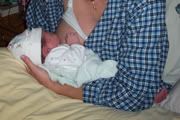 As shown the photo at right, the cross-cradle hold is not what one thinks of as the "traditional" image of breastfeeding, with the baby's head nestled in the crook of the elbow on the side of the nursing breast. That position is known as the "cradle hold" and is an instinctive way for a mother to nurse, and by far the most common hold she will probably use throughout the nursing relationship.
As shown the photo at right, the cross-cradle hold is not what one thinks of as the "traditional" image of breastfeeding, with the baby's head nestled in the crook of the elbow on the side of the nursing breast. That position is known as the "cradle hold" and is an instinctive way for a mother to nurse, and by far the most common hold she will probably use throughout the nursing relationship. However, cradle position creates some challenges for a brand-new, floppy and inexperienced baby and a new tired new mother who are both just learning how to nurse. Cross-cradle is a latching hold that will help align the baby properly against the mother's body as well as alighn the baby's mouth properly with the breast. These two things will help ensure proper breast stimulation and milk transfer as well as reduce the likelihood of sore nipples due to incorrect latch.
Here's why cross-cradle is an especially effective "starter" position:
-- As in the photo the baby is held with the opposite arm of the breast being used, with the neck and base of the head resting in the hand of that arm. This gives the mother the ability to control the baby's head and tilt the head back just slightly to allow for the free flow of milk through the throat (cradle position can push the baby's head down towards the chest until the baby has better control, an uncomfortable way to eat!).
-- In cross-cradle, the baby's back naturally rests against the arm, aligning the ear, shoulder and hip in a line towards the ceiling. In cradle, the baby's back is often flat against the lap or pillow, causing the head to turn perpendicular from the body (again, an uncomfortable way to eat).
-- Cross-cradle frees the arm on the same side of the breast to position the nipple for the baby. This is much less awkward than reaching over the top with the other arm in cradle. This enables the mother to ensure a good, deep latch of the baby's mouth on the breast. (See the link at the end of this article for a great illustration of how both hands are effectively used in cross-cradle hold.)
-- Once the baby has latched properly and has started nursing, the mother can stay in this position if comfortable, or can gently and carefully "transition" to cradle hold. Slowly lift the baby's body with the supporting arm and slip the other arm underneath the baby, cradling the head in the crook of the elbow. Then slowly remove the original supporting arm.
Cross-cradle hold is a great way to get a newborn baby positioned properly for an effective and painless latch. If the opportunity, it's a great idea to take a breastfeeding class that will actually teach this position to parents and have an expectant mother practice the position with a doll so that it won't feel awkward when the baby arrives. This is also a chance to get feedback and fine tuning, but if no class is available, practicing solo can still be quite useful to figure out where all the mother's and baby's parts belong.
“Illustration of both hand/arm positions in cross-cradle” from Texas WIC
For more information on getting started breastfeeding, here's two of my favorite books:


